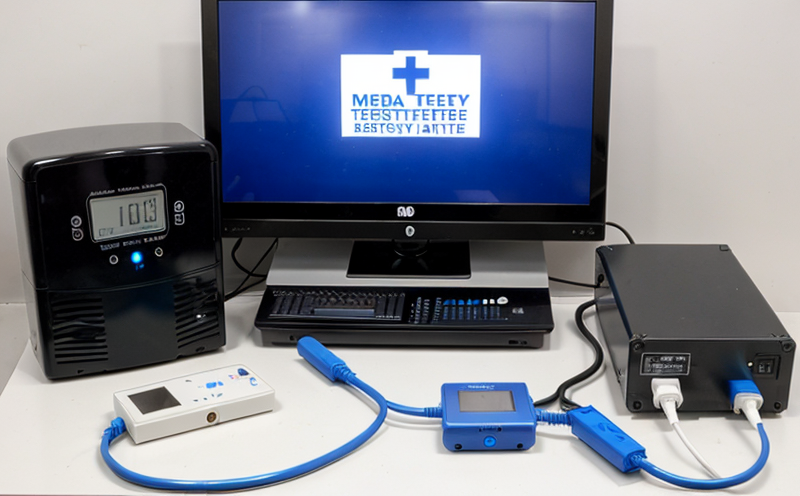Medical Device Battery Testing
The medical device industry places a high premium on reliability and safety. Medical devices that are powered by batteries must be rigorously tested to ensure they perform as expected under various conditions. This is particularly critical for life-critical devices such as pacemakers, insulin pumps, and defibrillators.
Battery testing in medical devices involves several parameters including voltage, capacity, internal resistance, discharge rate, and cycle life. The primary goal of this testing is to verify that the battery meets all performance criteria outlined by regulatory bodies like the US Food and Drug Administration (FDA) and the International Organization for Standardization (ISO).
The testing process typically involves multiple stages, each designed to simulate real-world conditions a medical device might encounter during its operational lifecycle. For instance, high-temperature storage tests are conducted to evaluate battery performance at extreme temperatures, while deep discharge and recovery tests assess how well the battery can handle prolonged use.
One of the key challenges in medical device battery testing is ensuring that the batteries meet stringent safety standards. This includes checking for potential hazards such as overheating, short-circuiting, and leakage. The test protocols are designed to mimic environmental factors like humidity and altitude, which could affect battery performance over time.
Another important aspect of this testing is durability testing. Here, the focus is on how well the battery holds its charge over multiple charging cycles. This is crucial for devices that require long-term operation without frequent recharging, such as implantable medical devices.
The results from these tests are critical in ensuring patient safety and regulatory compliance. Quality managers and R&D engineers rely heavily on accurate test data to make informed decisions about product design and manufacturing processes. By investing in thorough battery testing, manufacturers can avoid costly recalls and potential legal issues.
- High-temperature storage
- Deep discharge and recovery tests
- Cycling and durability testing
- Safety checks for hazards like overheating and leakage
- Environmental stress testing (humidity, altitude)
In summary, medical device battery testing is an essential part of the product development process. It ensures that devices perform reliably under all expected conditions, thereby enhancing patient safety and regulatory compliance.
Why It Matters
The reliability and performance of batteries in medical devices can have significant implications for patient health and well-being. A malfunctioning battery could lead to critical failures such as device shutdowns or performance degradation, which might result in serious consequences.
The FDA has stringent guidelines on the safety and efficacy of all medical devices, including those powered by batteries. These regulations are designed to protect patients from potential risks associated with substandard products. By adhering to these standards, manufacturers can ensure that their devices meet the highest quality benchmarks.
Battery testing also plays a crucial role in ensuring compliance with international standards like ISO 14960 and EN 50601-1. These standards provide clear guidelines on how batteries should be tested and what criteria must be met for medical devices to be considered safe and effective.
From an operational standpoint, reliable battery performance is essential for maintaining the functionality of critical devices. For instance, pacemakers rely on their batteries to deliver life-saving electrical impulses continuously. If a battery fails in such a device, it could result in severe health complications or even death.
In addition to safety and efficacy, battery testing also contributes to improving the overall quality and performance of medical devices. By identifying potential weaknesses early in the development process, manufacturers can address these issues before they become significant problems. This not only enhances product reliability but also improves patient outcomes.
Scope and Methodology
The scope of battery testing for medical devices encompasses a wide range of parameters that are critical to ensuring the safety, efficacy, and longevity of these devices. The primary focus is on evaluating the performance characteristics under various operational conditions.
The methodology involves subjecting batteries to a series of tests designed to simulate real-world scenarios. These include high-temperature storage tests, deep discharge and recovery tests, cycling and durability testing, and safety checks for potential hazards such as overheating, short-circuiting, and leakage.
High-temperature storage tests are conducted to assess how well the battery performs at elevated temperatures. This simulates conditions that might occur in warm environments or during prolonged use. Similarly, deep discharge and recovery tests evaluate the battery's ability to handle prolonged periods of operation without significant performance degradation.
Cycling and durability testing is crucial for assessing the long-term reliability of the battery. This involves subjecting the battery to multiple charging cycles to determine its capacity retention over time. The goal here is to ensure that the battery continues to provide reliable power even after extended use.
Safety checks are an integral part of the testing process, focusing on identifying potential hazards that could compromise device performance or safety. These tests include checking for signs of overheating, short-circuiting, and leakage, all of which can have serious consequences if not addressed early in the development process.
Environmental stress testing is another critical aspect of battery testing for medical devices. This involves exposing the batteries to various environmental factors such as humidity and altitude. These tests help ensure that the batteries continue to perform reliably under a wide range of conditions, enhancing their overall durability and reliability.
Why Choose This Test
- Ensures compliance with international standards like ISO 14960 and EN 50601-1
- Identifies potential hazards such as overheating, short-circuiting, and leakage early in the development process
- Evaluates performance under various operational conditions to ensure reliability and longevity
- Simulates real-world scenarios for high-temperature storage, deep discharge, cycling, durability, and environmental stress testing
- Improves overall product quality by addressing potential weaknesses before they become significant issues
- Enhances patient safety by ensuring that critical devices function reliably under all expected conditions
- Avoids costly recalls and potential legal issues associated with substandard products
- Provides accurate test data for informed decision-making by quality managers, compliance officers, and R&D engineers





